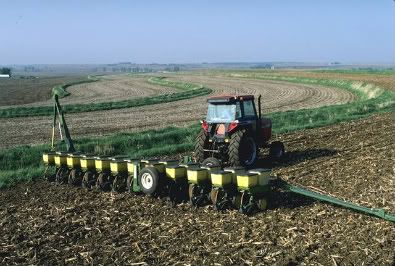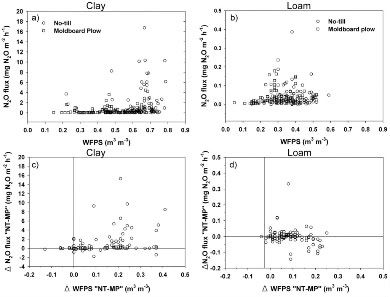No-till in trouble: increased N2O emissions offset reduced CO2 emissions in some soils

The practice of no-till has increased considerably during the past 20 years. The absence of tillage coupled with the accumulation of crop residues at the soil surface modifies several soil properties but also influence nitrogen dynamics. Soils under no-till usually host a more abundant and diverse biota and are less prone to erosion, water loss, and structural breakdown than tilled soils. Their organic matter content is also often increased. In addition, no-till has been proposed as a measure to mitigate the increase in atmospheric carbon dioxide concentration. But to accurately assess the net effect of no-till on greenhouse gas emissions, other gases also have to be examined, in particular N2O.
Researchers at Agriculture and Agri-Food Canada (Québec City) investigated the short-term impacts of no-till on soil nitrous oxide emissions. They compared emissions of nitrous oxide as well as nitrogen contents and physical properties between moldboard plowed (early fall) and no-till soils near Québec City, Canada. Measurements were made during three growing seasons in a poorly drained clay and a well-drained loamy soil cropped to barley. The results of the study were reported in the 2008 September-October issue of the Soil Science Society of America Journal (available for free for 30 days, here).
The authors concluded that their investigation indicates that there is a limited potential of no-till farming in fighting climate change:
No-till can result in incremental nitrous oxide emissions that can more than offset the soil carbon dioxide sink during the first 5 yr after adoption of this soil conservation practice in a heavy clay soil. Consequently, the potential of no-till for decreasing net greenhouse gas emissions may be limited in fine-textured soils that are prone to high water content and reduced aeration.
Differences in the response of nitrous oxide emissions when converting to a no-till practice between the clay and loam soils were striking. While emissions were similar in both tillage treatments in the well-aerated loam, they more than doubled under no-till in the clay soil (graph, click to enlarge):
 energy :: sustainability :: biomass :: bioenergy :: farming :: agriculture :: soils :: no-till :: greenhouse gas emissions :: climate change ::
energy :: sustainability :: biomass :: bioenergy :: farming :: agriculture :: soils :: no-till :: greenhouse gas emissions :: climate change :: Differences in emissions between tillage practices in the clay soil were observed in spring and summer but were greater and more consistent in the fall after plowing operations. The influence of plowing on nitrous oxide flux in the heavy clay soil was likely the result of increased soil porosity that maintained soil aeration and water content at levels restricting denitrification and nitrous oxide production. Accordingly, denitrification rates are usually increased in denser and wetter no-till soils and the anticipated benefits of the adoption of soil conservation practices on net soil-surface greenhouse gas emissions could be offset by increases in nitrous oxide emissions.
Predicting the impacts of no-till on nitrous oxide emissions is required for a full assessment of the influence of this practice on net greenhouse gas emissions. Researchers at Agriculture and Agri-Food Canada are pursuing their investigations to understand the factors that control the mechanisms leading to nitrous oxide emissions under contrasting soil tillage practices.
Specifically, they now focus their efforts on the role of soil aeration with the hypothesis that the “adoption of no-till only increases nitrous oxide emissions in poorly aerated soils”. Field studies and mathematical modeling of the impact of no-till on soil nitrous oxide emission has yielded contrasting results and an explanation of the high intersite variability of the influence of no-till on soil nitrous oxide emissions is still lacking.
Graph: Flux of N2O as a function of water-filled pore space (WFPS) in (a) a heavy clay soil and (b) a loamy soil, and difference in N2O flux between no-till (NT) and moldboard plow (MP) plots ({Delta}N2Oflux as NT – MP) as a function of difference in WFPS ({Delta}WFPS as NT –MP) in (c) a heavy clay soil and (d) a loamy soil. Credit: Rochette et al, & Soil Sci Soc Am J.
References:
Philippe Rochette, Denis A. Angers, Martin H. Chantigny and Normand Bertrand, "Nitrous Oxide Emissions Respond Differently to No-Till in a Loam and a Heavy Clay Soil", Soil Sci Soc Am J., 72:1363-1369 (2008), DOI: 10.2136/sssaj2007.0371
 --------------
--------------
 Mongabay, a leading resource for news and perspectives on environmental and conservation issues related to the tropics, has launched Tropical Conservation Science - a new, open access academic e-journal. It will cover a wide variety of scientific and social studies on tropical ecosystems, their biodiversity and the threats posed to them.
Mongabay, a leading resource for news and perspectives on environmental and conservation issues related to the tropics, has launched Tropical Conservation Science - a new, open access academic e-journal. It will cover a wide variety of scientific and social studies on tropical ecosystems, their biodiversity and the threats posed to them.










2 Comments:
Hi,
This is an interesting publication. Thanks for the reference.
What would the impact of biochar ammendment have on no-till land?
I discussed the results of the AAFC study with Dr. Rochette after it was published. The research shows higher N20 emissions from no-till in E Canada but not in W Canada. Part of the reason is the wetter soils in E Canada. However the soil on which the research was conducted in E Canada has only been under no-till management for a short term. The land studied in W Canada has been under a longer term no-till rotation. Thus my question is: If long term no-till land in E Canada was compared, (there is land in QC and ON that has been under no-till for 15 yrs or more) would we still see N20 emissions. My guess is that the soil structure changes that occur under long-term no-till (10 yrs plus) will provide better aeration and porosity which will result in lower N20 emissions or provide a net sink situation, like we have in Western Canada. I recommended to AAFC that more studies are necessary on LT no-till land in Central Canada before we can say N20 emissions are a problem under no-till management in E Canada and other similar areas.
Doug McKell
Executive Director
Soil Conservation Council of Canada
Post a Comment
Links to this post:
Create a Link
<< Home